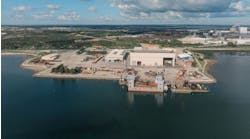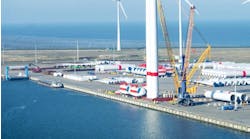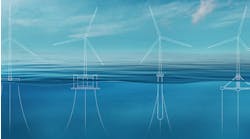Opinion: How the future of floating wind will be shaped by operations and maintenance
By Wouter Maas, Fugro
Large floating wind farms are expected to be built and run on a massive scale over the coming years. In fact, according to RenewableUK, the total global pipeline of floating wind projects has doubled in the last year and now totals a massive 180 GW.
The reason there’s such high interest in floating wind is because it presents opportunities for new areas of energy production. Higher offshore wind increases capacity and enables more consistent production, which is urgently needed to meet global energy demands. Indeed, widespread adoption of floating wind could be one of the biggest innovations to accelerate the transition to renewable energy.
Nevertheless, floating projects are still in their early stages, and many developers find themselves in the process of making some major decisions around floating designs—whether that’s floaters, anchors or moorings. Ultimately, each of these design concepts will have different implications when it comes to deciding the operations and maintenance (O&M) approach—from floating-to-floating, to tow-to-port, tow-to-shore or a self-hoisting crane.
O&M cost implications
Current costs of operating and maintaining floating wind projects are up to five times greater than fixed sites. Conditions farther offshore are noticeably more turbulent than at permanent locations, so structures will be continually shifting. As a result, offshore workers will have a harder time reaching sites and (once they are there) resolving any concerns. Wind farm operators will therefore need to account for weather delays, extended transit times and increased training to maintain worker safety.
It seems inevitable that the overall levelized cost of energy (LCOE) of floating wind sites will increase due to higher O&M expenses. LCOE is the ratio between total discounted lifetime cost and total discounted lifetime production, and it’s the holy grail in the offshore industry.
So, wind farm developers are going to be looking for reassurance that the benefits of floating wind will not be overshadowed by high O&M costs during the lifetime of an asset.
The function of offshore monitoring
The cost of running floating wind farms could be greatly reduced by remote monitoring. With this technology, an operator could detect problems such as fatigue, corrosion and scour early by remotely monitoring turbines using a set of specialized sensors, without offshore staff needing to travel to the site. This could be critical in reducing the number of subsea inspections.
When wind turbines are farther offshore, remote monitoring will help asset managers to receive early warning of any concerns, which will also help to minimize costly in-person site visits.
Operators also will need to plan their visits around seasons and weather conditions to avoid any hazardous conditions. Undoubtedly, monitoring will be essential to identify the best window of time for site visits and maintenance visits.
For developers currently planning floating sites, whatever design they are considering, now is the moment to think about how they could leverage automated and digitalized data delivery to give early warnings of wear or failure and improve asset performance. This data-driven strategy will help them to make better judgements, improve safety and reduce the overall LCOE.
The determining factor
Floating wind holds enormous promise as a sustainable energy source. However, long-term O&M requirements must be carefully examined for projects to be a genuinely viable alternative to fixed locations (and fossil fuels).
This cannot be an afterthought for developers that are already evaluating various floating wind concepts. To lower the costs of renewable energy, O&M must be a key consideration in the planning and construction of future sites.




